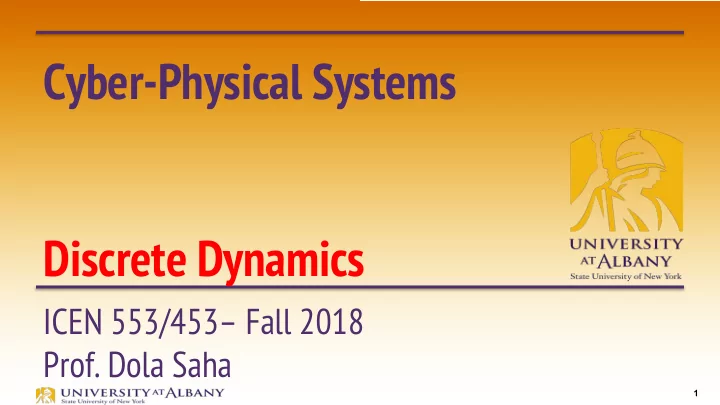

Cyber-Physical Systems Discrete Dynamics ICEN 553/453– Fall 2018 Prof. Dola Saha 1
Discrete Systems Ø Discrete = “individually separate / distinct” Ø A discrete system is one that operates in a sequence of discrete steps or has signals taking discrete values . Ø It is said to have discrete dynamics . Ø A discrete event occurs at an instant of time rather than over time. 2
Discrete Systems: Example Design Problem Ø Count the number of cars that are present in a parking garage by sensing cars enter and leave the garage. Show this count on a display. 3
Discrete Systems Ø Example: count the number of cars in a parking garage by sensing those that enter and leave: 4
Discrete Systems Ø Example: count the number of cars that enter and leave a parking garage: Ø Pure signal: up : R → { absent , present } Ø absent: no event at that time ; present: event at that time 5
Discrete Systems Ø Example: count the number of cars that enter and leave a parking garage: Ø Pure signal: up : R → { absent , present } Ø Discrete actor: Counter : ( R → { absent , present } ) P → ( R → { absent } ∪ N ) P = { up , down } 6
Demonstration of Ptolemy II Model (“Program”) 7
Actor Modeling Languages / Frameworks Ø LabVIEW Ø Simulink Ø Scade Ø … Ø Reactors Ø StreamIT Ø … 8
Reaction / Transition For any t � R where up ( t ) ⇥ = absent or down ( t ) ⇥ = absent the Counter reacts . It produces an output value in N and changes its internal state . State: condition of the system at a particular point in time • Encodes everything about the past that influences the system’s reaction to current input 9
Inputs and Outputs at a Reaction For t ∈ R the inputs are in a set Inputs = ( { up , down } → { absent , present } ) and the outputs are in a set Outputs = ( { count } → { absent } ∪ N ) , 10
Question Ø What are some scenarios that the given parking garage (interface) design does not handle well? For t ∈ R the inputs are in a set Inputs = ( { up , down } → { absent , present } ) and the outputs are in a set Outputs = ( { count } → { absent } ∪ N ) , 11
State Space A practical parking garage has a finite number M of spaces, so the state space for the counter is States = { 0 , 1 , 2 , ··· , M } . 12
Garage Counter Finite State Machine (FSM) Guard g ⊆ Inputs is specified using the shorthand up ∧ ¬ down which means g = {{ up }} . Inputs(up) = present, Inputs(down) = absent 13
Garage Counter Finite State Machine (FSM) Initial state 14
Garage Counter Finite State Machine (FSM) Output 15
Ptolemy II Model 16
FSM Modeling Languages / Frameworks • LabVIEW Statecharts • Simulink Stateflow • Scade • … 17
Garage Counter Mathematical Model Formally: ( States , Inputs , Outputs , update , initialState ) , where • States = { 0 , 1 , ··· , M } • Inputs = ( { up , down } → { absent , present } The picture • Outputs = ( { count } → { absent } ∪ N ) above defines the • update : States × Inputs → States × Outputs update function. • initialState = 0 18
FSM Notation Input declarations Output declarations state Extended state declarations transition initial state self loop 19
Examples of Guards for Pure Signals Transition is always enabled. true Transition is enabled if p 1 is present . p 1 Transition is enabled if p 1 is absent . ¬ p 1 Transition is enabled if both p 1 and p 2 are present . p 1 ∧ p 2 Transition is enabled if either p 1 or p 2 is present . p 1 ∨ p 2 Transition is enabled if p 1 is present and p 2 is absent . p 1 ∧ ¬ p 2 20
Guards for Signals with Numerical Values Transition is enabled if p 3 is present (not absent ). p 3 Transition is enabled if p 3 is present and has value 1. p 3 = 1 p 3 = 1 ∧ p 1 Transition is enabled if p 3 has value 1 and p 1 is present . Transition is enabled if p 3 is present with value greater than 5. p 3 > 5 21
Example of Modal Model: Thermostat 22
When does a reaction occur? Ø Suppose all inputs are discrete and a reaction occurs when any input is present . Then the below transition will be taken whenever the current state is s1 and x is present. Ø This is an event-triggered model . 23
When does a reaction occur? Ø Suppose x and y are discrete and pure signals. When does the transition occur? Answer: when the environment triggers a reaction and x is absent. If this is a (complete) event-triggered model, then the transition will never be taken because the reaction will only occur when x is present! 24
When does a reaction occur? Ø Suppose all inputs are discrete and a reaction occurs on the tick of an external clock . Ø This is a time-triggered model . 25
More Notation: Default Transitions Ø A default transition is enabled if it either has no guard or the guard evaluates to true. When is the below default transition enabled? 26
Default Transitions Ø Example: Traffic Light Controller 27
Recommend
More recommend